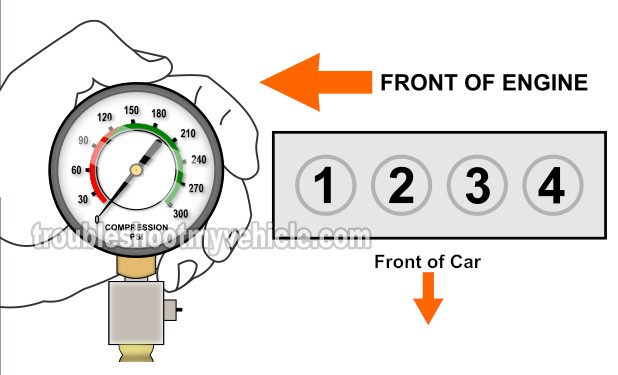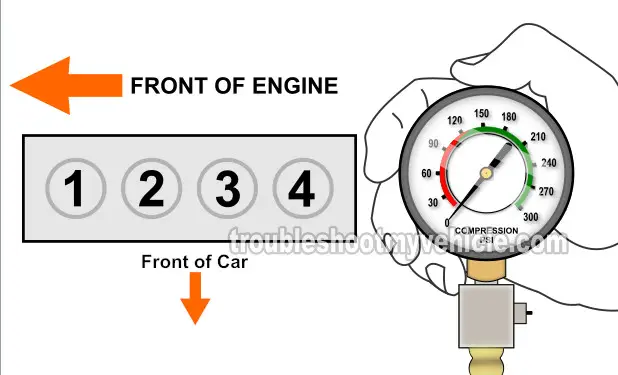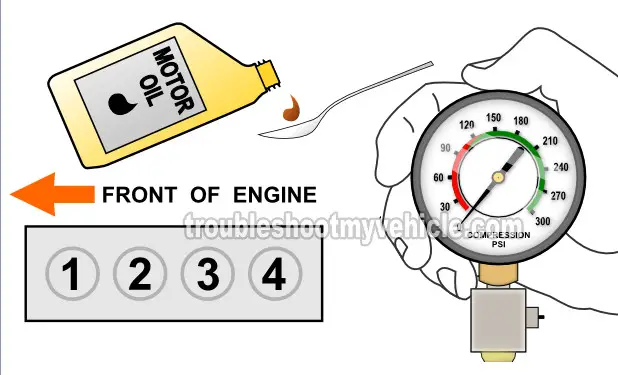
As the engine in your car starts to age and accumulate miles, the piston rings and cylinder head valves start to wear. Eventually they'll reach a point of wear and tear that'll cause engine compression problems.
These engine compression problems usually manifest themselves in one of two ways. Either your car is going to misfire or it's not going to start.
Thankfully, testing the engine compression, in your 1.8 Mazda Protegé, is not that hard. What makes the engine compression test easy is that the spark plugs are easy to remove. In this tutorial I'm gonna' teach you how to test it and more importantly how to interpret its results.
Contents of this tutorial:
ES ![]() You can find this tutorial in Spanish here: Cómo Probar La Compresión Del Motor (1995-2000 1.8L Mazda Protegé) (at: autotecnico-online.com).
You can find this tutorial in Spanish here: Cómo Probar La Compresión Del Motor (1995-2000 1.8L Mazda Protegé) (at: autotecnico-online.com).
Symptoms Of Low Or No Engine Compression
As I mentioned at the beginning of the tutorial, engine compression problems fall into 2 different categories. Either the engine starts but misfires (runs rough), or the engine doesn't start at all.
In this section, we're gonna' analyze both types of problems and see the specific symptoms they produce:
Engine Starts but Runs with a Misfire (Rough Idle):
- Also known as an engine miss, rough idle condition.
- Usually caused by very low compression in one cylinder or...
- Uneven engine compression that varies more than 15% across all 4 cylinders.
- Check engine light on with misfire codes:
- P0300 Random Cylinder Misfire.
- P0301 Cylinder #1 Misfire.
- P0302 Cylinder #2 Misfire.
- P0303 Cylinder #3 Misfire.
- P0304 Cylinder #4 Misfire.
- Bad gas mileage.
- This is caused engine not producing its optimal power output since the air/fuel mixture isn't being combusted with adequate compression pressure.
- Engine pollutes more.
- If the air/fuel mixture isn't compressed within a certain range, it won't burn optimally and produce more unburned hydrocarbons escaping into the exhaust.
Your 1.8L Mazda Protegé won't start:
This usually is caused by having 2 or all 4 cylinders with no compression. When this happens, you'll see:
- The engine cranks very fast.
- This fast cranking speed is very noticeable.
- The Ignition System is sparking all 4 spark plugs.
- This tells you that the no-start condition is not caused by a fault in the ignition system.
- The fuel injectors spray fuel.
- You can confirm this with a Noid Light test.
- Also, you can confirm this, although indirectly, by removing the spark plugs and checking to see if they are fuel soaked (fuel fouled).
- Fuel pump is working and providing pressure.
- The most common causes of no compression on 2 or all 4 cylinders are:
- Blown head gasket.
- Broken timing belt.
- Engine threw a rod.
OK, having covered the most common scenarios of low compression and no compression, let's get testing to see if this is the case on your 1.8L Mazda Protegé equipped vehicle.
Which Compression Tester Should I Buy?
There are lot of engine compression testers to choose from and many places to buy them. I'm gonna' make some recommendations to you:
Disclosure: As an Amazon Associate, I earn from qualifying purchases. If my tutorials help you, using these links is an easy way to support the site at no extra cost to you. Thank you!
TEST 1: Finding The Dead Cylinders

To get this show on the road, we'll start off by testing the compression of all four cylinders. In case you're wondering where you can get your hands on a compression tester, you can borrow one from your local auto part store, buy it from them, or, to save a few bucks, you can buy it on-line.
If you need help deciding where to buy one or which one to buy, take a look at my recommendations: Which Compression Tester Should I Buy?
Alright, to get the most accurate snapshot of the health of each cylinder it's a good idea to start the engine and let it run for about 15 minutes and no more. Don't let it get hot. Or if it has been running for any length of time, let it cool down completely. You should not remove the spark plugs from a hot engine or you run the risk of stripping the spark plug threads in the cylinder head.
IMPORTANT: You'll be working around a cranking engine, so you have to be careful and stay alert at all times. Think safety all of the time!
This is what you'll need to do:
- 1
If the engine starts, let it warm up for about 5 minutes, before you start this test (but don't let it get hot!).
NOTE: If your Mazda doesn't start, then don't worry about the engine being warm. - 2
Disconnect all of the fuel injectors. This will prevent fuel from being injected into the cylinders as you crank the engine.
- 3
Remove all four spark plugs.
As you're taking them out, be careful and don't drop any of them on the floor, or you could cause the spark plugs ceramic insulator to break, and this will cause a misfire! - 4
Thread the engine compression gauge into the spark plug hole for the number 1 engine cylinder (this is the spark plug hole closest to the drive belt).
Hand tighten the compression gauge only! Do not use any type of tool to get it tight. - 5
When the tester is set up, ask your helper to crank the engine. Your job is to keep your eye on the compression tester's gauge.
- 6
Once the needle on the gauge stops climbing, have your helper stop cranking the engine.
- 7
Write down the compression value on a piece of paper.
Include the number of the cylinder this reading belongs to. - 8
Now repeat steps 4 thru' 6 on the other 3 cylinders.
Let's take a look at what your test results mean:
CASE 1: Low or no compression in 2 or all 4 cylinders. This test result indicates a serious internal problem.
The most common issues would be:
- Blown head gasket.
- To further test this, I recommend the following tutorial: How To Test For A Blown Head Gasket (1.6L Mazda Protegé) (NOTE: This info will apply to your 1.8L Mazda Protegé equipped vehicle).
- Broken timing belt.
- Engine threw a rod.
CASE 2: Low or no compression in one cylinder. Getting a no or low compression test result means you've found the cause of the engine's rough idle (misfire).
If you got a low compression reading, the next step is to find out if this reading is varying by more than 15% than the other cylinders (because if it is varying by more than 15%, then this cylinder is considered 'dead'). To find out go to: Interpreting Your Compression Test Results.
Interpreting Your Compression Test Results
If you're reading this section, then your compression test results indicate you've got one or more cylinders producing a low compression value.
Up to certain point, a low compression value will not cause any problems.
But if the compression value varies by more than 15% of the highest one, then you've got a cylinder that will cause a misfire.
Alright, finding out if the low compression value is causing a problem can be done in one of two ways: You can calculate this 15% difference with pen and paper.
Or you can use my low compression calculator. You can find the low compression calculator here: Online Low Engine Compression Calculator (at: easyautodiagnostics.com).
If you want to manually calculate the 15% difference, here's what you'll need to do:
- STEP 1: Multiply the highest compression value by 0.15 (this is the decimal value of 15%).
- STEP 2: Round the result to the nearest one (for example: 25.6 would become 26).
- STEP 3: Subtract the result (the number that was rounded) from the highest compression value.
- ANSWER: The result of this subtraction is the lowest possible compression value any cylinder can have.
Now, let me give you a more specific example: Let's say that I got the following compression readings:
| Cylinder | Pressure |
|---|---|
| #1 | 165 PSI |
| #2 | 95 PSI |
| #3 | 155 PSI |
| #4 | 175 PSI |
My next step is to do the following calculation:
- STEP 1: 175 x 0.15 = 26.25.
- STEP 2: 26.25 = 26 (rounded to nearest one).
- STEP 3: 175 - 26 = 149.
- ANSWER: 149 PSI. Any cylinder with this compression (or lower) value will misfire.
Since cylinder #2 is only producing 95 PSI, I can now conclude that it's 'dead' and causing a misfire.
To find out if the lowest compression value you got from your engine compression test is within a good range, you'll need to do the same calculation. Of course, you'll need to use the highest compression value you got and not the one in the example.
Once you've found the 'dead' cylinder, the next step is to find out what's causing the low compression value. For this step, go to: TEST 2: 'Wet' Engine Compression Test.
TEST 2: 'Wet' Engine Compression Test

If you've reached this point, you've found one or several cylinders with low or no compression. You might be wondering what's causing this compression test result. In this test section, we're going to find out with a very simple and easy test.
This test involves adding about two tablespoons of engine oil to the cylinder that gave you a low or no compression test result in TEST 1. After adding the oil to the cylinder (with low or no compression), we're going to test its compression again.
Why add the engine oil? Because the engine oil will help to determine if the problem is in the piston rings, or if the problem is in the cylinder head valves.
OK, this is what you need to do:
- 1
Add a small amount of engine oil to the cylinder that reported low compression or no compression in the 'Dry' compression test.
The amount should be about 1 to 2 tablespoons of oil. - 2
Install the compression tester onto the cylinder.
Do not use any type of tool to tightened the compression tester. Hand tight is fine. - 3
When all is set up, have your helper crank the engine.
- 4
You'll get one of two results:
1.) The compression value will go up (from the one you recorded before).
2.) The compression value will stay the same.
Let's see what it all means:
CASE 1: The compression value shot up. This tells you that the piston compression rings are worn out and thus the problem is in the bottom end (block) of the engine in your 1.8L Mazda Protegé.
CASE 2: The compression value stayed the same. This confirms that the low compression problem of the affected cylinder is due to worn or damaged cylinder head valves.

If this info saved the day, buy me a beer!





